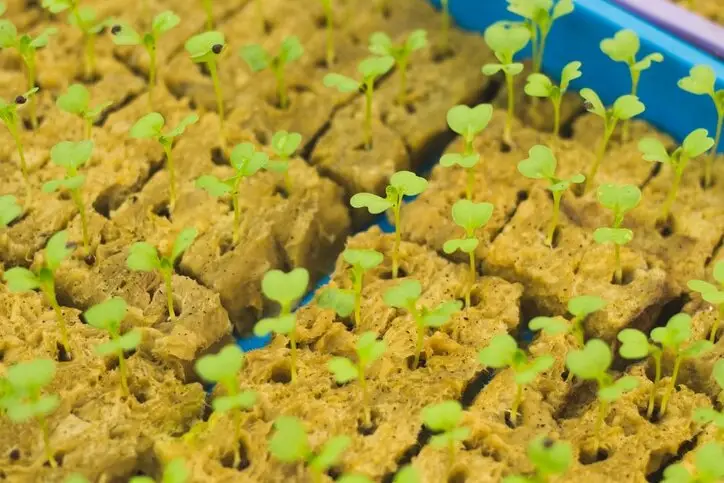Hydroponic and Microgreen media – pros and cons

The pros and cons of Coir, Perlite, Rockwool, and Vermiculite
Let's explore the pros and cons of other popular options like perlite, vermiculite, and coco coir, considering their suitability for both hydroponic and microgreen growing:
Perlite
- Pros:
- Excellent drainage: Perlite's lightweight, volcanic rock granules provide exceptional drainage, preventing root rot.
- Neutral pH: Unlike rockwool, perlite has a neutral pH, eliminating the need for pre-adjustment.
- Aeration: The porous structure allows excellent air circulation, promoting healthy root growth.
- Reusable: Perlite can be sterilized and reused, making it economical.
- Cons:
- Nutrient retention: Perlite retains minimal nutrients, requiring frequent feeding in hydroponic systems.
- Dust: Handling dry perlite can generate dust, requiring proper ventilation and potentially posing respiratory concerns.
- Not ideal for microgreens: While suitable for hydroponic systems, perlite's loose nature might not provide enough support for fast-growing microgreens.
Vermiculite
- Pros:
- Moisture retention: Vermiculite absorbs and retains moisture well, reducing watering frequency.
- Nutrient holding capacity: Compared to perlite, vermiculite holds nutrients better, benefiting plants between feedings.
- Lightweight: Similar to perlite, vermiculite's low weight won't burden hydroponic systems.
- Cons:
- Drainage: While it retains moisture, vermiculite drains slower than perlite, increasing root rot risk if overwatered.
- pH drift: Vermiculite tends to raise the pH over time, requiring monitoring and adjustments.
- Dust: Similar to perlite, handling dry vermiculite can generate irritating dust.
- Cost: Vermiculite is generally more expensive than perlite.
Coco Coir
- Pros:
- Organic and sustainable: Made from coconut husks, coco coir is biodegradable and eco-friendly.
- Excellent drainage and aeration: Coco coir offers good drainage while retaining some moisture, balancing aeration and hydration.
- Nutrient holding capacity: Like vermiculite, coco coir holds nutrients effectively, reducing feeding frequency.
- Buffering pH: Coco coir naturally buffers pH fluctuations, simplifying nutrient management.
- Cons:
- Initial preparation: Coco coir often requires buffering and flushing before use to remove excess salts.
- Decomposition: Coco coir breaks down over time, requiring replacement more frequently than perlite or vermiculite.
- Potential fungal issues: Coco coir can be susceptible to fungal growth if not properly managed.
- Availability and cost: Depending on location, coco coir might be less readily available and slightly more expensive than other options.
Rockwool
Pros:
- Sterile: Rockwool is sterile, reducing the risk of disease transmission.
- Supportive: The firm texture provides good support for seedlings and cuttings.
- Durable: Rockwool lasts for multiple growing cycles with proper care.
- pH neutral: Similar to perlite, rockwool has a neutral pH, eliminating pre-adjustment needs.
Cons:
- Initial pH adjustment: While neutral, rockwool can raise the pH of nutrient solutions over time, requiring monitoring and adjustments.
- Nutrient retention: Like perlite, rockwool retains minimal nutrients, necessitating frequent feeding in hydroponic systems.
- Can be challenging for beginners: Rockwool's rigidity can make it slightly trickier to handle and plant seeds compared to looser media like coco coir.
- Potential environmental impact: Rockwool production can be energy-intensive, raising concerns about its sustainability compared to organic options like coco coir.
Choosing the Right Medium
The best hydroponic medium depends on your specific needs and preferences. Consider factors like:
- Plant type: Different plants have varying needs for drainage, aeration, and moisture.
- Hydroponic system: Some systems might be better suited for specific media types.
- Maintenance preferences: Opt for media that aligns with your desired watering and feeding frequency.
- Sustainability: Choose eco-friendly options like coco coir if environmental impact is a concern.
Microgreen Considerations
For microgreens, which have a rapid growth cycle and require good support, a combination of media might be ideal. Consider mixing perlite with vermiculite for drainage and moisture balance, or using coco coir for its nutrient holding capacity and buffering properties.
In Conclusion
Remember, experimentation is key! Don't hesitate to try different media and combinations to find what works best for your hydroponic and microgreen endeavors.
I hope this information expands on the article and provides valuable insights for choosing the right hydroponic media for your needs!

